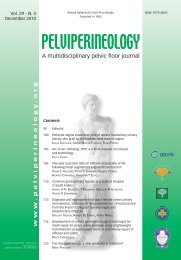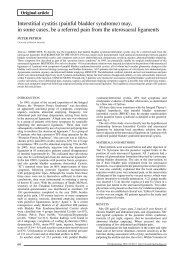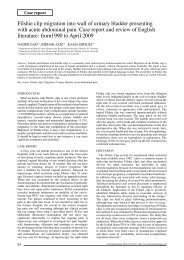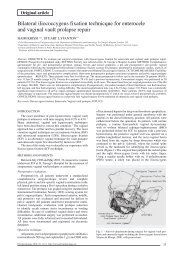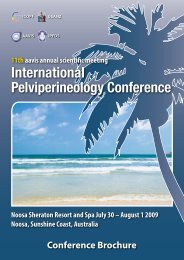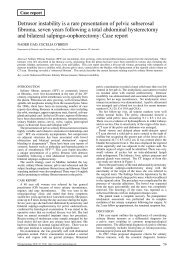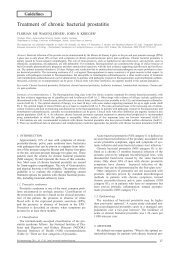This Issue Complete PDF - Pelviperineology
This Issue Complete PDF - Pelviperineology
This Issue Complete PDF - Pelviperineology
You also want an ePaper? Increase the reach of your titles
YUMPU automatically turns print PDFs into web optimized ePapers that Google loves.
V. Kalis - J. Stepan Jr. - Z. Novotny - P. Chaloupka - M. Kralickova - Z. Rokyta<br />
absorbed in 42 days and its tensile strength is none (0 lb<br />
from original 10 lb) after two weeks. The suture begins to<br />
fall off in just 7 to 10 days. So this is ideal material if no<br />
wound tension after 7-10 days is acceptable. Coated Vicryl<br />
is absorbed in 56-70 days and its tensile strength is at 75%<br />
(10 lb from original 14 lb) after two weeks. 19<br />
No study has been clearly focused on the layer of perineal<br />
muscles. No study has as yet explored the advantage of new<br />
sutures with antibacterial properties for suturing the perineal<br />
muscles.<br />
DeLancey and Hurd show that urogenital hiatus is sealed<br />
by the vaginal walls, endopelvic fascia, and urethra. Once<br />
the urogenital hiatus has opened up, the vaginal wall and<br />
cervix lie unsupported. The constant vector of abdominal<br />
pressure on the fascia can cause its failure. It is ultimately<br />
the perineal body that is the mechanism for preventing prolapse<br />
beyond the urogenital hiatus. 20<br />
The layers traversed during uncomplicated mediolateral<br />
episiotomy are: epithelium, bulb of vestibule, Bartholin’s<br />
gland (occasionally), bulbospongiosis, superficial transverse<br />
perinei, perineal membrane, urethrovaginal sphincter and<br />
transversus vaginae. 21 Puborectalis muscle is rarely ever<br />
involved in this incision and so not afflicted by this procedure.<br />
When repairing an episiotomy, the suture of perineal<br />
muscles seems to be the crucial step for an obstetrician or<br />
midwife in preventing a decrease in the pelvic floor muscle<br />
strength.<br />
The aim of this survey was to map the current situation in<br />
Europe and to describe common types of material and styles<br />
of suturing perineal muscles after episiotomy in European<br />
hospitals.<br />
MATERIALS AND METHODS<br />
In the year 2006, an email or postage questionnaire study<br />
was sent to different European hospitals. The question<br />
related to this project was as follows:<br />
Which type of material and methods of suturing are used<br />
in your hospital for perineal muscles?<br />
Hospitals of 27 EU countries, of 3 countries which had initiated<br />
entrance talks to the EU, plus Iceland, Israel, Norway<br />
and Switzerland, were asked to answer a mediolateral episiotomy<br />
questionnaire.<br />
RESULTS<br />
A total of 122 hospitals in 34 European countries participated<br />
in this project and sent back their answers. Sixty eight<br />
hospitals are situated in the original 15 EU countries, 44<br />
hospitals are from countries which entered the EU later or<br />
are involved in entrance talks, and 10 hospitals are located<br />
in the four remaining countries: Iceland, Israel, Norway and<br />
Switzerland.<br />
Type of suturing material<br />
A total of 110 hospitals reported that one type of suture<br />
material is used for perineal muscle repair while 12 hospitals<br />
answered that they use alternatively two types of sutures.<br />
None of the hospitals uses more than two different sutures<br />
in their standard approach.<br />
Altogether 13 different types of sutures are currently in<br />
use across Europe. These are shown in table 1.<br />
The most common suture type is a polyglactin 910 suture<br />
(Coated Vicryl, Vicryl RAPIDE or Vicryl PLUS Antibacterial),<br />
that is used in 96 hospitals (more than 70%). Polyglactin<br />
910 is followed by polyglycolic acid (Safil, Safil<br />
Quick, Dexon II), used by 16 hospitals (12%) and traditional<br />
gut sutures (catgut, chromic catgut) are used in 13 hospitals<br />
(10%). Non-absorbable suture was reported by only one<br />
TABLE 1. – Material for suturing of perineal muscles.<br />
Material<br />
Mention<br />
(N) (%)<br />
1 Catgut 8 6<br />
2 Chromic catgut 5 3.5<br />
3 Dexon II 5 3.5<br />
4 Safil 7 5<br />
5 Safil Quick 4 3<br />
6 Coated Vicryl 40 29.5<br />
7 Vicryl RAPIDE 55 41<br />
8 Vicryl PLUS Antibacterial 1 1<br />
9 Monocryl 1 1<br />
10 Chirlac rapid braided 2 1.5<br />
11 Assucryl synthetic 1 1<br />
12 Polysorb 1 1<br />
13 Ethilon 1 1<br />
14 Not exactly specified<br />
absorbable material 3 2<br />
Total 134 100<br />
NB.: The total number amounts to 134 (12 hospitals use two materials<br />
alternatively).<br />
institution that also uses some other absorbable material.<br />
Catgut and/or chromic catgut are used as the only suture in<br />
11 hospitals (9%).<br />
Considering short- and mid-term absorbable synthetic<br />
sutures, we found that short-term absorbable sutures (Safil<br />
Quick, Vicryl RAPIDE, Chirlac rapid braided) are used by<br />
61 hospitals (50%). Mid-term absorbable sutures (Dexon<br />
II, Safil, Coated Vicryl, Vicryl PLUS Antibacterial, Assucryl<br />
synthetic, Polysorb) are used for suturing the perineal<br />
muscles in 55 hospitals (46%). Monocryl, whose absorption<br />
time is somewhere between short- and mid-term is used<br />
by one hospital. Only one hospital reported using a new<br />
absorbable synthetic suture with Triclosan (Vicryl PLUS<br />
Antibacterial), that has antibacterial properties.<br />
Fifty one hospitals (46%) use only short-term absorbable<br />
synthetic sutures and 49 (44%) use only mid-term absorbable<br />
sutures for perineal muscle repair. In 8 hospitals (8%)<br />
both types of sutures were used and 3 hospitals (2%) were<br />
not specific about their absorbable material.<br />
Size of the suturing material<br />
As for sizes of the sutures, we received 96 answers of<br />
which 3 hospitals referred to two alternative sizes. In 26<br />
remaining responses (8 using catgut only) the hospitals did<br />
not give details regarding the size of sutures used for perineal<br />
muscle repair.<br />
Among the hospitals which use only one type of material<br />
and only one size, the most frequent response was 2-0 Vicryl<br />
RAPIDE - 32 cases, followed by 0 and 2-0 Coated Vicryl,<br />
both reported by 13 institutions. All details are shown in<br />
table 2.<br />
Method of suturing of perineal muscles<br />
In the catgut group 5 hospitals did not answer. From the<br />
remaining 6 hospitals, only one hospital uses both techniques<br />
(continuous or interrupted), and a remaining 5 hospitals<br />
suture perineal muscles with interrupted stitches only.<br />
From 111 hospitals which use an absorbable synthetic<br />
material for suturing the muscles, 89 hospitals answered in<br />
full with 27 (30%) hospitals use continuous sutures, and 42<br />
(47%) hospitals interrupted sutures. Twenty (23%) hospi-<br />
18



